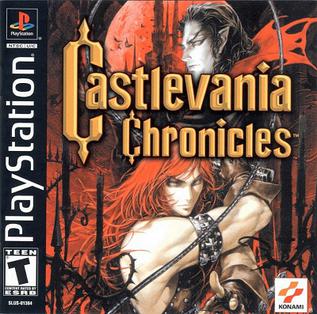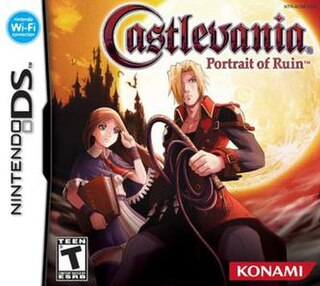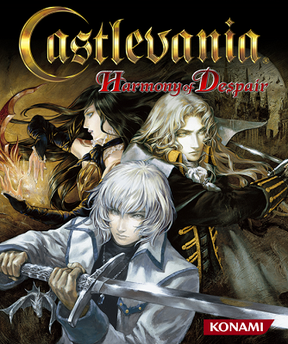
Castlevania, known in Japan as Akumajō Dracula, is a gothic horror action-adventure video game series and media franchise about Dracula, created and developed by Konami. It has been released on various platforms, from early systems to modern consoles, as well as handheld devices such as mobile phones. The franchise has expanded into several spin-off video games and other media, including comic books and an animated television series.

Adrian Fahrenheit Țepeș, better known as Alucard, is a character in Konami's Castlevania series of video games. His first appearance in the series was in the 1989 game Castlevania III: Dracula's Curse, but he is best known for his role in the critically acclaimed Castlevania: Symphony of the Night, released in 1997. His design in Symphony of the Night was created by Ayami Kojima, marking her first contribution to the Castlevania franchise.

Castlevania: Symphony of the Night is an action role-playing game developed and published by Konami for the PlayStation and Sega Saturn. It was directed and produced by Toru Hagihara, with Koji Igarashi acting as assistant director. It is a direct sequel to Castlevania: Rondo of Blood, taking place four years later. It features Dracula's dhampir son Alucard as the protagonist, rising from his slumber to explore Dracula's castle which resurfaced after Richter Belmont vanished. Its design marks a break from previous entries in the series, re-introducing the exploration, nonlinear level design, and role-playing elements first experimented with in Castlevania II: Simon's Quest.

Castlevania: Rondo of Blood, originally released in Japan as Akumajō Dracula X: Chi no Rondo, is a platform-adventure video game developed by Konami for the PC Engine's Super CD-ROM² System directed by Toru Hagihara. Part of the Castlevania series, protagonist Richter Belmont goes to save his lover Annette, who was abducted by Dracula. It was first released exclusively in Japan on October 29, 1993. A direct sequel, Castlevania: Symphony of the Night, was released worldwide in 1997.

Castlevania II: Simon's Quest is a platform-adventure game developed and published by Konami. It was originally released in Japan in 1987 for the Famicom Disk System, and in North America in 1988 for the Nintendo Entertainment System. It is the second Castlevania game released for the NES, following the original Castlevania (1986). Set seven years after the events of the first installment, the player once again assumes the role of vampire hunter Simon Belmont, who is on a journey to undo a curse placed on him by Dracula at the end of their previous encounter. Dracula's body was split into five parts, which Simon must find and bring to the ruins of Castle Dracula in order to defeat him. The game deviates from the traditional platforming of its predecessor, incorporating role-playing and open world elements.

Castlevania: Circle of the Moon, titled Castlevania in PAL regions, is a platform video game created by Konami for the Game Boy Advance. Published as a launch title in 2001, Circle of the Moon is part of Konami's Castlevania video game series, the premise of which centers on the eternal conflict between the vampire hunters of the Belmont clan and the vampire Dracula. The game sold one million copies worldwide and was acclaimed by critics. The events of its plot were retconned by former Castlevania producer Koji Igarashi, a move which was met with some criticism.

Castlevania: Dawn of Sorrow is a 2005 action-adventure game developed and published by Konami. It is part of Konami's Castlevania video game series and the first Castlevania game released on the Nintendo DS. The game is the sequel to Castlevania: Aria of Sorrow and incorporates many elements from its predecessor. Dawn of Sorrow was commercially successful. It sold more than 15,000 units in its first week in Japan and 164,000 units in the United States during the three months after its initial release.

Castlevania: Curse of Darkness is an action-adventure game, part of the Castlevania franchise. It is the second 3D Castlevania title developed by Konami Computer Entertainment Tokyo, released in 2005 following Castlevania: Lament of Innocence and was available for PlayStation 2 and Xbox in all regions except Japan, where the game was only available on PlayStation 2. Curse of Darkness received mixed reviews, common praise was directed towards its combat system, music, content, and replay value, while criticism fell towards its story, characters, repetitive level-design and gameplay.

Castlevania: Legacy of Darkness is an action-adventure platforming video game, that was developed and published by Konami for the Nintendo 64. It was released in 1999 and is a prequel and expanded version of Castlevania, also released on the Nintendo 64 earlier the same year; it contains a remake of the original game with improved graphics, added villains, and alternate versions of some levels.

Castlevania Legends is the third Castlevania title released for the original Game Boy. It was released in Japan on November 27, 1997 and in Europe and North America on March 11, 1998.

Super Castlevania IV is a platform video game developed and published by Konami for the Super Nintendo Entertainment System. It has been re-released multiple times, including for the Super NES Classic Edition.

Haunted Castle is a side-scrolling platform game released by Konami for arcades in 1987. It is the second arcade game in the Castlevania franchise, following Vs. Castlevania, an arcade port of the original 1986 NES video game released in North America. Unlike the previous arcade title in the franchise, Haunted Castle is not a direct port of an existing console game, but a newly-developed arcade game running on custom JAMMA-based board.

Castlevania Chronicles is a video game compilation developed by Konami Computer Entertainment Tokyo for the PlayStation. It consists of two game modes: Original Mode, which is a port of the 1993 platform video game Akumajō Dracula for the Sharp X68000 home computer, and Arrange Mode, a modernized remake featuring a new introductory cinematic, new sprites, and re-balanced gameplay among other adjustments. The Sharp X68000 version of Akumajō Dracula is, itself, an updated remake of the original Castlevania for the NES, where the vampire hunter Simon Belmont must defeat Dracula and save Transylvania. The compilation was later released for the PlayStation Network as a PSone Classic in December 2008.

Castlevania: Portrait of Ruin is a platform-adventure game developed and published by Konami. The game was released on November 16, 2006 in Japan, and in North America on December 5, 2006 for the Nintendo DS handheld game console. Portrait of Ruin is the first Castlevania to feature a cooperative multiplayer gameplay mode and the first handheld Castlevania to have English voice-overs, outside of its original Japanese release.

Castlevania: Order of Ecclesia is a platform-adventure game and the third Nintendo DS installment of the Castlevania franchise. Directed by Akihiro Minakata, with producer Koji Igarashi returning. The plot involves Shanoa, who is part of an organization set to defeat Dracula after the Belmont clan has vanished.

Castlevania: The Arcade, released in Japan as Akumajō Dracula: The Arcade, is an arcade game, part of the Castlevania franchise by Konami. The game was announced on July 23, 2008. The game was released in Japan on October 2, 2009. A European release was announced for 2009 but only appeared at test locations in 2008.

Castlevania: Harmony of Despair is a platform-adventure game in the Castlevania series developed and published by Konami for Xbox 360 in August 2010, and for PlayStation 3 in 2011.

Castlevania, known in Japan as Akumajō Dracula, is a platform game developed and published by Konami for the Family Computer Disk System video game console in Japan in September 1986. It was ported to cartridge format and released in North America for the Nintendo Entertainment System (NES) in May 1987 and in Europe in 1988. It was also re-issued for the Family Computer in cartridge format in 1993. It is the first game in Konami's Castlevania video game series.

Simon Belmont is a fictional character who serves as the first protagonist to appear in the Castlevania series. He appears in Castlevania, Vampire Killer, Haunted Castle, Castlevania II: Simon's Quest, Super Castlevania IV, and Castlevania Chronicles, and acts as a supporting character in Castlevania Judgment and Castlevania: Harmony of Despair. He also appeared as a playable character in DreamMix TV World Fighters and Super Smash Bros. Ultimate. Simon has received positive reviews from critics.




















